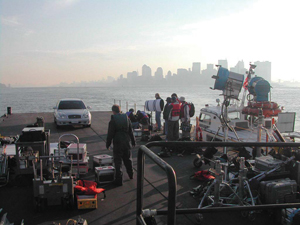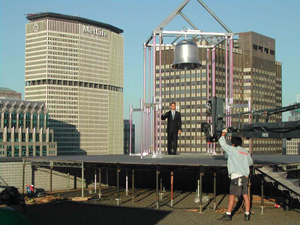Filming on the streets of New York City
It would seem that most Earthlings know New York City. They may have visited without having left home: Central Park, Times Square and other icons have made countless appearances in the global media.
But for those of us who live here, and live by production here, the city remains the same but changes daily, shrinks and expands. It is very familiar but highly mysterious. Location Scouts explore it for years but getting to know the Big Apple is to know how much is not known.
Size matters. At 303 square miles, our five-borough joint is much smaller than megatropoli like Tokyo and London. Still, NYC is 6,400 miles of streets and avenues in 59 community districts encompassing over 180 separate, named sections such as Park Slope, Harlem and Astoria. They all have discrete, distinctive neighbourhoods. Big is right.
 I’ve been a Location Scout (pictured left on set) since interning on an indie film in 1994, and a Location Manager since 1996. By subway, car, boat, foot and once in a helicopter, I’ve trekked several thousand miles around the Big Apple, from Chelsea Piers on the Hudson River to Far Rockaway, Queens, on the verge of Nassau County (16 miles/26 km); from an outlying neck of Staten Island to the brim of The Bronx and Westchester County (24 miles/ 38 km). Those extremes would be a grueling two-day walk or a stop-and-go two-hour drive.
I’ve been a Location Scout (pictured left on set) since interning on an indie film in 1994, and a Location Manager since 1996. By subway, car, boat, foot and once in a helicopter, I’ve trekked several thousand miles around the Big Apple, from Chelsea Piers on the Hudson River to Far Rockaway, Queens, on the verge of Nassau County (16 miles/26 km); from an outlying neck of Staten Island to the brim of The Bronx and Westchester County (24 miles/ 38 km). Those extremes would be a grueling two-day walk or a stop-and-go two-hour drive.
On most of that expanse, productions packing more than a camera, a tripod and five people need permission to shoot from the location owner and/or MOFTB (Mayor’s Office of Film, Theatre and Broadcasting). The one definitive rule for shooting is: follow the rules. Parking rules, for instance.
Squeezing a crew onto some hyperactive city streets can be like fitting a football team into a two-door sedan. But in 2009, 188 films managed it.
However, all is relative: ‘big’ can be parking for five production vehicles and a crew of 30. Ten vehicles and 60 is equal to several subway cars, and 20 and 100 is Godzilla and King Kong, who of course have visited us in three movies.
MOFTB and Location Managers on shoots large and small perform this magic with the Schedule A and The Grid (MOFTB’s 'who, what and where' production parking spreadsheet). If or when neighbourhood associations conclude that gear, trucks and noisy crews have taken up precious curbs and pavements too often, MOFTB may temporarily place the area on the off-limits no-permits Hot Spot List.
 The economic times and some steps of the process are changing. In July 2010, MOFTB set a USD300 fee for permits that had been issued without charge since its inception in 1966. Also, productions now pay for access to previously fee-free city-owned locations such as courtrooms and offices. NYPD assistance, however, remains free and that is surely a good deal. The 26-member Movie TV unit, aka the TCD (Traffic Control Division), assists shoots of all sizes on request or as needed or required for public safety.
The economic times and some steps of the process are changing. In July 2010, MOFTB set a USD300 fee for permits that had been issued without charge since its inception in 1966. Also, productions now pay for access to previously fee-free city-owned locations such as courtrooms and offices. NYPD assistance, however, remains free and that is surely a good deal. The 26-member Movie TV unit, aka the TCD (Traffic Control Division), assists shoots of all sizes on request or as needed or required for public safety.
As the face of the city on-set they will watch over a two-man crew photographing a huge truck parked in the middle of Third Avenue, stand by simulated crime scenes and violence, help to close some streets for the midtown Bourne Ultimatum car chase, or all of Times Square for the Vanilla Sky sequence of Tom Cruise running through its desolate dawn. The credits list is long.
Complex sequences may require many meetings between productions and the TCD at the MOFTB, and if necessary, NYPD Traffic Enforcement and even the DOT (Department of Transportation).
Despite the challenges of tight space and a fast pace, high visibility or large-scale street shoots are not rare.
How to find locations for an impressive big scene/sequence? Job one, of course, is to ask people like the Director and Production Designer what they want and dial up the abundant A-to-Z candidates we scouts have stored in collective minds and photos. Then we round up the usual suspects, strategise and go hunting. Four-star hotels, deserted sinister piers, office tower skyline rooftops, dive bars and clubs for divas; you name it. Finding options is usually easy but clearing the shoot, doing a deal and moving the crew into and around the location can be a hat-trick that’s not for the anxious or time-stressed manager.
 My own mother of all location battles was fought in September of 2002. The Sixth Avenue office tower rooftop location chosen for a Korean securities commercial had given permission on Tuesday afternoon and agreed to sign and fax the contract to me the next morning. Then, after a delay to late Wednesday afternoon, without warning the approved location opted out with all the delicacy of a hammer smashing a thumb.
My own mother of all location battles was fought in September of 2002. The Sixth Avenue office tower rooftop location chosen for a Korean securities commercial had given permission on Tuesday afternoon and agreed to sign and fax the contract to me the next morning. Then, after a delay to late Wednesday afternoon, without warning the approved location opted out with all the delicacy of a hammer smashing a thumb.
Just like that, I had nowhere to send more than 30 crew members, 300 square feet of concert platform, an Arri 435, a remote Zebra head, a multi-piece Phoenix crane, a Fisher 10 dolly and ten meters of track, large props, craft service and pop-up tents. A tsunami of panic swept through me.
Starting to seek a replacement on Thursday morning for a big shoot commencing Saturday at dawn seemed more like three-bullet Russian roulette than production.
But hang tough I did. By that evening, I was directing everyone to another, better, 44th floor roof. The Producer stopped snarling at me. After three sleep-deprived nights to prep a 16-hour shoot day, and many exhausting heavy-lift trips up and down three double-height staircases (no elevator past 40) I had truly earned my money and gotten some invaluable lessons as a bonus.
The sunny shoot was perfection and, on a clear day, I believe that good eyes can see the Bronx and perhaps even Far Rockaway from that roof.
Images courtesy of Mark McKennon and The Location Station - www.scoutman.com
Related Posts
Comments
Not Logged in
You must be logged in to post a comment










There are 4 comments
Murray Ashton
| #
Nice one Mark..what's next? Best, Murray
Reply